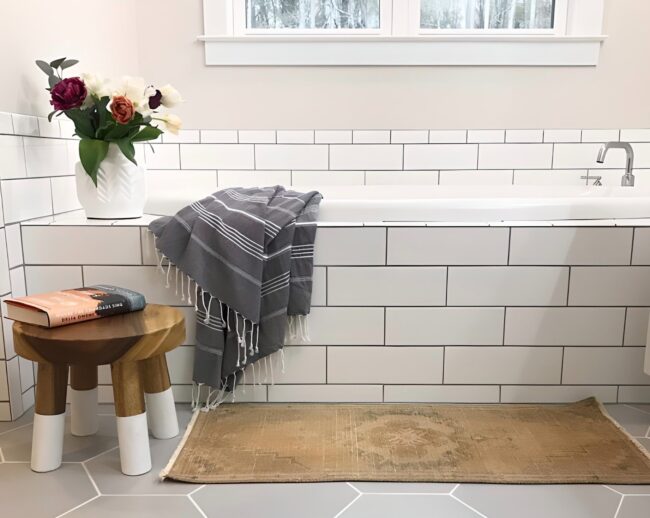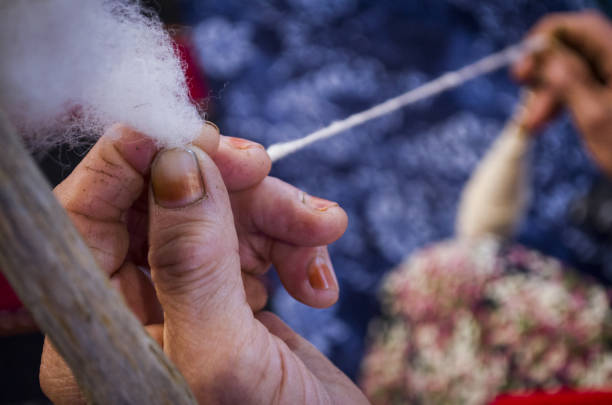
It can be hard to know what to look for when you buy a Turkish rug for the first time because each one has a lot of history, expertise, and small details woven into it. But it’s also a very fulfilling excursion that lets you feel the warmth of Anatolian culture and workmanship that has been there for hundreds of years. If you think about it and discover what’s important, your first rug will be more than just a purchase; it will be a treasure for life.
Understand the Difference Between Handmade and Machine-Made Rugs
It’s not just about quality that hand-made rugs are different from machine-made ones. It’s about the soul. Because each knot is tied with care and tradition, handmade Turkish rugs feel like human hands. You can feel it. Machine-made rugs may look great at first, but they don’t last long and are occasionally created with synthetic materials that might irritate delicate skin. They could fade, wear out quickly, or even smell like chemicals.
I recall poking around online and not being sure what I was seeing. Then I noticed a rug from Kirmen Rugs that was hand-knotted. It was soft, had a lot of details, and had little faults that made it look real. It arrived in perfect form, and it still looks bright and intriguing now. I knew the actual difference when I saw that. Look for rugs that have knots you can see on the back, tiny asymmetries, and changes in texture that happen naturally. If you’re purchasing in a store or online, this is how to know if the rug is real.
Check the Materials Used
You can tell a lot about how a Turkish rug feels, what it does, and how long it will endure by looking at what it’s composed of. Wool and cotton are the most common and usually the best choices. Wool is soft, warm, and lasts a long time. The rug is robust and flat because it is made of cotton, which is typically used for the basis (warp and weft).
Some local rugs are made of goat hair and, less often, silk. But silk isn’t the best choice for first-time buyers because it’s so fragile and pricey. Wool and cotton are wonderful for spaces that get a lot of use, such beds, living rooms, and entryways. This is especially true if they are dyed organically.
Some carpets from the southern sections of Turkey are softer and more flexible, which makes them great for places where comfort is crucial, like a reading nook. These rugs are made of wool, which makes them feel bouncy, and lanolin, which makes them less prone to become dirty or damp. I thought it was a good idea to have a wool rug because it was warm, sturdy, and looked fantastic after a while.
Pay Attention to Knot Density and Craftsmanship
Knot density isn’t the only method to tell if a rug is good, but it is a good clue of how much work and effort went into manufacturing it. When there were more knots, the design was usually more intricate and took longer to build. Gently flip the rug over and look at the back to determine if this is true. You can see the knots and how tight they are in handmade rugs.
But crafting is more than just numbers. It also has to do with fit. Are the pictures symmetrical? If so, they should be. Do the colors look good together? Is the edge binding strong? Even if there are some imperfections, a well-crafted Turkish rug should reflect that it was manufactured with care. Later, I found out that the first blanket I bought had little, irregular edges since it was manufactured on a loom for nomads. It only made me like it more.

Examine the Colors and Dyes
The colors in a Turkish rug can transform the way a space looks and also tell you how real it is. Natural dyes made from plants, roots, and animals tend to generate deep, layered tones that don’t shout for attention. These hues may age beautifully, giving rugs a gloss that machines can’t make.
When you choose colors, think about the colors in your home. Most rooms look fantastic with earthy tones like rust, brown, or indigo. Some Anatolian weaves use delicate pastel colors that can make rooms that are dark look brighter. I chose a lovely red and blue piece that now holds up my living room. It changes a little with the light, but it’s always warm and never too much.
Inspect the Condition of the Rug
If you like old Turkish rugs, which you should, you should think about how good they are. The fabric and strength of well-knotted ancient carpets make them last a long period. But others may show symptoms of wear, such frayed ends, minor fading, or a pile that is a touch worn. I don’t think of these as defects; I think of them as the rug’s memories.
Rugs that are quite old, especially those that are more than 100 years old, may be easier to break. People commonly hang them on walls or position them in places where not many people walk by to make a point. If you want to walk on it every day, don’t buy an old rug. Buy a rug from the past instead. If you’re still not sure, certain sellers, like Kirmen Rugs, do an excellent job of making these aspects evident in their marketing.
Consider the Rug’s Size and Placement
Size isn’t only about how something fits; it’s also about how it looks. If the rug is too little, the space could feel empty. If the rug is too wide, the room might feel overly full. Small spaces like bathrooms or reading nooks are perfect for sizes like 2×3 or 2×4 feet. They help the furniture look better and make footsteps seem less loud without taking over the room.
Runners look fantastic in kitchens and halls, especially vintage ones that make the room feel warm and inviting right away. You should think about whether you want the legs of all the furniture to show through the floor in the living room and bedroom, or just the front ones. This will help you decide between medium and large sizes. The only item that really brought the whole area together was the old mid-sized rug I used to decorate the dining room.
Request a Certificate of Authenticity
One of the primary things that first-time buyers worry about is making sure the rug they buy was genuinely created by hand. A Certificate of Authenticity is more than just a formality; it proves that the rug wasn’t made in a factory but by someone who learnt how to make it over many generations. Sellers who are good won’t think twice about giving this.
The blanket I bought online arrived with a certificate that told me where it came from, how old it is, what kind of cloth it is made of, and how to tie the knots. Knowing the complete story made me feel better. Look for merchants who highlight trustworthiness and offer proof when you buy something online. If they don’t, that’s a sign that you should be careful. This is normal on some sites, like Kirmen Rugs, which makes it easier to shop for rugs online.
Logistics are also important. When you buy anything huge and expensive, free shipping, quick returns, and friendly customer support are all important features to look for in a good platform. You can choose Kirmen Rugs, they send our certificates without our request.
Buy From a Trusted Seller or Platform
It’s really crucial to trust the person you buy your first Turkish rug from. You can only learn so much from pictures. What actually matters is the seller’s experience, honesty, and values. There are a lot of postings for rugs, and some of them don’t give the complete picture.
Look for sites that have clear photographs of the products, reviews you can trust, and good customer service. A good site will not just aim to sell you something, but it will also help you comprehend what you’re buying. That’s why I bought from a vendor who seemed more like a curator than a store. If you wish to start this procedure, you should seek for Turkish rugs for sale on a trustworthy website that has clear return policies and thorough adverts.
Some of these sites, like Kirmen carpets, sell not only carpets but also the stories that go with them. They have a well picked collection of antique rugs, and they present each one with care and good explanations. There aren’t many locations like this where shopping online doesn’t feel like a risk. It feels like you’re shopping for yourself.
